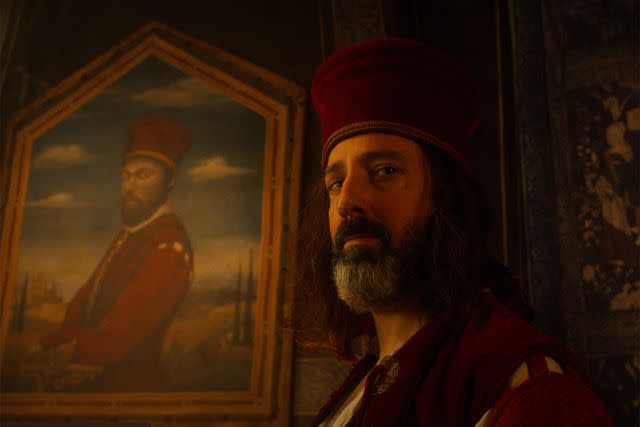Was “The Decameron ”a true story?“ ”Everything to know about the dark comedy set during the Black Death

It's a tale of wine-soaked chaos amid bubonic plague.
Netflix's The Decameron turns a real-life historical tragedy into a boisterous comedy.
The series from Kathleen Jordan centers on turmoil in Florence in 1348. Upon the onset of the Black Death in Italy, high-class nobles and their servants relocate to a countryside villa to await the end of the bubonic plague pandemic. As their Italian town is crumbling beyond their borders, the ensemble engages in frivolous fun, wine tastings, and scandalous sexual affairs. The cast includes Amar Chadha-Patel, Leila Farzad, Lou Gala, Karan Gill, Tony Hale, Saoirse-Monica Jackson, Zosia Mamet, Douggie McMeekin, Jessica Plummer, and Tanya Reynolds.
Since the Black Death was a real historical event, you might be wondering: What is The Decameron based on? It's far too absurd to be a true story. Was it a book? Who was it penned by? Well, EW has you covered. Here's everything you need to know about The Decameron's source material and more.
Related: The Black Death creates chaos in exclusive trailer for The Decameron
What is 'The Decameron' based on?

The Decameron is loosely based on a 14th-century collection of fictional short stories. Unfortunately, this means that the Decameron's characters are not based on real historical figures. In a satirical and timely examination of human nature, the tales depict 10 Italians fleeing to the country to avert the plague, as in Jordan's series. The text is different from the series and centers around young aristocrats (seven women and three men). On each evening, one person takes a turn playing king or queen and commanding how the next day will be spent.
What does "Decameron" mean?
"Decameron" is Greek for "10 days." It represents the duration of 10 days spent at the country villa. The collection contains 100 stories, told from each of the 10 character's perspectives within the span of those 10 days.
Who is the author of 'The Decameron'?

The story collection was written by Italian author and poet Giovanni Boccaccio. Boccaccio was born in Florence in the 1300s and grew up during the era of nobles and servants. Boccaccio developed an interest in writing short stories and poetry during his adulthood, and he began a career writing thought-provoking works. He soon became one of the founders of The Renaissance Humanism movement in the 14th century, when authors like him, Dante Alighieri, and Petrarch (also known as The Three Jewels) wrote timely stories about humanity and class during a religious era. The movement originated in Italy during the 14th century and gradually spread across Europe until the 15th century. Between 1348 and 1353, Boccaccio wrote The Decameron, which was his finest, most famous, and most influential work of literature.
What inspired Boccaccio to write 'The Decameron'?

Netflix
Tony Hale in 'The Decameron'Boccaccio lived during the time of the Black Death. He witnessed firsthand the impact of the plague, which killed his father and stepmother, along with the death toll of over 100,000 Florentines, according to Boccaccio. Having lived through the pandemic, Boccaccio was compelled to write the tales in order to, in his words, "offer some solace...to those who stand in need of it."
What were Giovanni Boccaccio's other famous works?

Although none of his other works reached the same fame as The Decameron, Boccaccio penned many other well-regarded works. His initial work of fiction was Caccia di Diana (Diana's Hunt), which revolved around the gathering of Neapolitan court ladies, who were instructed to hunt for the goddess Diana. Another one of Boccaccio's famous works was Genealogia Deorum Gentilium (Ancestry of the Pagan Gods) an ambitious manuscript he worked on in between writing The Decameron and other projects. From the years 1350 to 1374, he compiled a detailed Mythography guidebook encompassing all the ancient Greek and Roman gods and their intertwined, genetic connections.
Why was 'The Decameron' banned?

Netflix
Zosia Mamet and Saiorse-Monica Jackson in 'The Decameron'The Decameron was banned in Italy between 1497 and 1559, long after Boccaccio's death in 1375. Boccaccio's works, which reflected individualism in a society that did not separate from church and state, were condemned by the Catholic Church. The Decameron was the most infamous for its overt satirical commentary on clericalism within Italy that existed during the Middle Ages.
Later in America, The Decameron was also banned from 1873 into the 1930s, because the 1873 Comstock Act outlawed abortion in addition to restricting speech by banning explicit books, including those that satirized religion or described sex in a detailed way. This affected living authors during the period, including Ernest Hemingway, John Steinbeck, William Faulkner, and F. Scott Fitzgerald. Women writers Ezra Heywood and Margaret Sanger were arrested for it.
What is the historical significance of 'The Decameron'?

The Decameron was the only work of fiction made during the Black Death that recorded the tragic events in excruciating detail. During his time in Italy, Boccaccio experienced the impact of the historical event on society and religion. While all of the book's stories were fictional, they were emblematic of what was happening in real time.
Sign up for Entertainment Weekly's free daily newsletter to get breaking TV news, exclusive first looks, recaps, reviews, interviews with your favorite stars, and more.
Read the original article on Entertainment Weekly.
